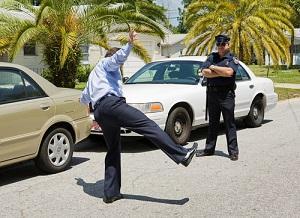Standardized Field Sobriety Tests, Part 2: The Walk-and-Turn
 For most people, walking several steps in a straight line then turning around and walking back is about as simple an action as there is. Doing so, of course, may be considerably more difficult for those who have been drinking. That is why the National Highway Traffic Safety Administration has recognized the "Walk-and-Turn" as one of the three assessments that comprise the standardized field sobriety tests (SFSTs) used by law enforcement nationwide.
For most people, walking several steps in a straight line then turning around and walking back is about as simple an action as there is. Doing so, of course, may be considerably more difficult for those who have been drinking. That is why the National Highway Traffic Safety Administration has recognized the "Walk-and-Turn" as one of the three assessments that comprise the standardized field sobriety tests (SFSTs) used by law enforcement nationwide.
In a recent post on this blog, we talked about the first test of the series—the horizontal gaze nystagmus (HGN). The walk-and-turn is the second test, and the third is the one-leg stand, which will be covered in the near future. Each test was selected to allow officers on the scene to observe a subject’s reflexes and involuntary responses, giving the officer the basis on which to suspect whether a driver is impaired.
Test 2: The Walk-and-Turn
There are two distinct phases of the walk-and-turn test. The first is the instruction phase, during which the officer asks the subject to stand heel-to-toe with his or her arms downs and at the side of the body. The officer explains the test and demonstrates how it should be performed. Before allowing the subject to begin, the officer will confirm that the subject understands the instructions. Then the second phase—the performance phase—begins.
During the test, the subject must walk nine steps, heel to toe, along a straight line—either painted on the ground or imaginary. The subject must then pivot 180 degrees and take nine steps back. Throughout the duration of the test, the subject’s arms must remain at his or her side while he or she watches his or feet and counts the steps aloud.
While watching the subject, the officer will be looking for certain indicators that suggest impairment. These include:
- Starting to walk before the instructions are complete;
- Stopping or raising the arms to regain balance;
- Takes the wrong number of steps or loses count; and
- Stepping off the line or not walking heel to toe.
Accuracy Concerns
When properly administered, the walk-and-turn test is accurate in predicting impairment between 66 and 79 percent of the time, depending on which studies one believes. Regardless of the number, the larger point is that the test does produce false positives. Many individuals suffer from conditions that affect their balance and gait, making a straight-line, heel-to-toe walk fairly difficult, if not impossible. With that in mind, it may be possible to challenge the results of the walk-and-turn—and the other SFSTs—with the help of your attorney.
If you have been charged with driving under the influence (DUI), contact an experienced Kane County criminal defense attorney for guidance. Call 847-488-0889 to schedule a free consultation at The The Law Office of Brian J. Mirandola today.
Sources:
http://www.fieldsobrietytests.org/walkandturntest.html
http://duijusticelink.aaa.com/issues/detection/standard-field-sobriety-test-sfst-and-admissibility/







